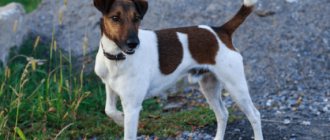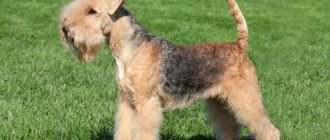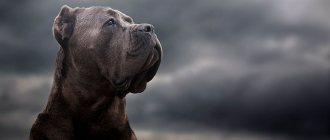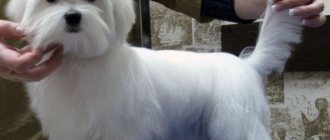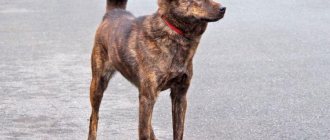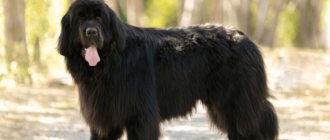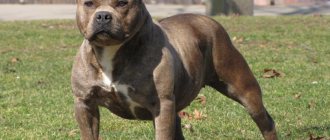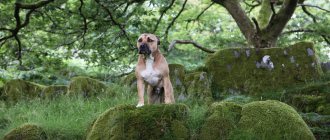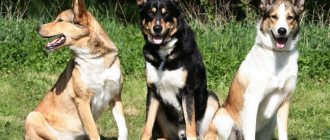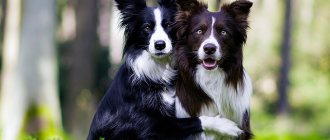Purpose of huskies
The amazing hunting instincts of northern dogs are genetically determined. The dog's goal is to track and bark at game. She must indicate the location of the beast, distract her from the hunter.
Dogs have an excellent sense of smell and a loud bark; they can track animals even after 12 hours; they also work in a team, for example, to hunt a bear.
The pet shows its best hunting skills:
- for small game - quickly finds and bites the neck, but does not damage the skin;
- on a squirrel or sable - covers vast territories and informs the hunter with a loud bark;
- on a capercaillie or hazel grouse - it almost sneaks, and when it gets close, it barks, indicating the place of the bird;
- for waterfowl - the dog walks alongside, carefully sniffs the scent of the bird, after shooting, rushes into the water and delivers it to the owner;
- at a bear - first it barks when the predator tries to leave, bites painfully on the legs, showing miracles of resourcefulness and speed of reaction.
Classification by purpose
photo from website: vashipitomcy.ru
Shepherd's
The ancestor of herding dogs was the Nenets Laika, which was bred in the north of the Scandinavian Peninsula. It is distinguished by its small size (up to 45 cm in height in males and 40 in females), thick and longer hair. The head has a wide skull and a convex forehead, a muzzle with pronounced cheekbones, round eyes, most often hazel-colored. The characteristics of Laika dogs from this subgroup are determined by their main occupation. They are born shepherds, but also good hunters who hunt not only game on the water, but also large animals - for example, a bear. Crossbreeds have less long hair. An increase in the occipital region also indicates unwanted crossing.
Riding
They are also called polar. This group is one of the largest. Dogs belonging to it were bred to transport goods and people. However, not only can they work in a harness, but they also help in tracking elk and bighorn sheep. General characteristics of representatives of this group: strong bones, powerful build, fairly high height at the withers (up to 60 cm in males), wide and well-developed chest.
Hunting We have described this group in sufficient detail above. It remains to add that they thought about strengthening the abilities of these dogs back in the nineteenth century. These animals have been highly appreciated by dog handlers and fishermen. Exterior features: erect and mobile ears (hence excellent hearing), developed coat of hair, allowing one to track animals at low temperatures, rounded eyes (not large, but not small), proportional build, wide chest.
Caring for your husky
The breeds were bred for the harsh northern climate; heat has a negative impact on the dog’s health.
During shedding, the coat should be combed twice a week with a stiff comb. At other times, the husky itself will monitor it. She is very clean.
Bathe your dog only when necessary. Otherwise, the beautiful “fur coat” will become dull and the natural fat will be washed off. Swim only with air conditioning.
The eyes never become sour; for prevention, it is permissible to wipe with a damp cloth.
Inspect your ears regularly, wipe the ears with a damp swab 2 times a month to prevent wax from accumulating.
Claws. If the dog leads an active life (running or hunting), they will wear off on their own. Otherwise, you will have to prune once every few months.
Inspect the dog's paws, avoid cuts and abrasions. Wipe paws with a damp cloth after going outside.
Official parameters
The standard exterior of the Nenets Laika ( reindeer Spitz ) is approved in most Russian cynological registries:
- Federation of Service Dog Breeding: 1994;
- Union of Kennel Clubs International (UCI): 1998;
- RKF: 1999;
- National Russian Cynological Association: 2000.
The documents declare a Spitz-shaped dog of below average height, compact build, and square format. Subtle beauty, exceptional intelligence, high working and adaptive abilities, stable psyche. The innate condition and talents of the breed allow the Arctic herding huskies in the most difficult climatic conditions, wherever a massive and vicious animal is not needed (in search and rescue services, forensics, travel, family leisure).
Departing from official formulations, we can briefly summarize: the herding Spitz of the Russian North: smart, beautiful and very compact animals with strictly limited functionality.
Height at the withers of toothy gentlemen: 44-52 / shaggy young ladies: 40-45 centimeters. Elongation: males: 102/104 / females: 104/108. Weight of adult animals - males: 21-25 / females 20-24 kilograms.
Coat
Nenets huskies are perfectly protected from arctic frosts: the dogs are perfectly “wrapped” in straight, long guard hair and a developed thick undercoat. The general impression of the dog: an animal with a lush coat with thick feathering on the cheekbones, mane of the withers and hips (gachas of the pants). On the muzzle near the eyes, as well as on the front side of the paws, the fur is short and very dense. The standard clearly stipulates the maximum length of the awn: mane - 15, tail decor - 25 or more (during the period of maximum growth) centimeters.
Colors
The color of Arctic Herding Spitz can be anthracite-black, brown, gray with white spots. Excessive multicoloring is not allowed, but zonal coloring is allowed. Dogs of these colors in beige-brown tones may have yellow pupils, beige jowls and a pink nose.
Shepherd personality
The temperament of the Nenets herding Spitz is balanced, but very bright. These are cheerful, dynamic and life-loving animals. Polar husky shepherds are absolutely confident in themselves - they are self-sufficient, temperamental dogs, sparkling with a lively mind. Centuries-old selection has created a type that is independent in solving complex problems and survives in any extreme conditions. Nenets herding huskies are clearly focused on the owner and service to him. These are non-aggressive and friendly animals: huskies easily make contact with a stranger, but never change their attachment to the owner-leader and members of his family. The dogs get along well in a pack and are capable of teamwork, but they consider any other small living creatures only as pasture.
When discussing the personal aspects of the variety, it is important to know and understand that Nenets reindeer Spitz dogs are talented only in large-scale reindeer herding. In all other canine professions, these dogs do not shine.
Nutrition
Determine immediately:
Dry food is convenient for trips or long trips with your husky.
Homemade food is healthier for such a dog. For good health, a balanced diet is essential.
Feed puppies 5 times a day, when they turn 0.5 years old - 4 times, and adults - 3 times a day.
Advice! Mixing dry food with homemade food is strictly prohibited!
Be sure to have a clean bowl of water, change the water 2 times a day!
Your pet needs to cook food! Cook porridge with meat broth. The dog must eat a portion; if it does not finish, reduce the amount of food.
After any walk (run), feed after 30 minutes.
Puppies can eat meat only when they are 1 year old. Only periodically can you give raw tripe for vitamins.
The diet includes: beef (no other meat), poultry, cleaned sea fish (no river fish!), dairy products (eggs, cottage cheese, kefir), nutritious porridges (buckwheat, rice, etc.), various vegetables and herbs.
You can give 1 fruit a day, monitor the reaction to avoid allergies.
Important! Do not give: spices, chocolate, soda, potatoes, smoked meats.
Choose the most inquisitive and nimble puppies, this is an indicator of excellent health. If you feed properly and lead an active life, you will gain a best friend, helper and protector.
We offer a photo gallery of all types of huskies.
Karelo-Finnish breed
The Karelo-Finnish husky is small in stature, very agile and strong. The animal's height is only 48 centimeters. External features are very similar to other breeds. The forests of Eastern Europe, as well as the Trans-Urals, are considered the homeland of dogs. The Karelian-Finnish dog is very active and has a strong hunting passion. Reacts very sensitively to education. Since the animal has increased excitability, a gentle and even attitude is required from the owner. This breed is very touchy. If the owner punishes his ward at least once, the animal remembers it forever and never trusts it again.
Photo of Laika dog
\
Samoyed breed
The Samoyed is a dog from the Laika breed. She is very beautiful, but has too independent a character. In addition, he loves open spaces, where he feels great. If we talk about the merits of the breed, then the Samoyed is not only a beautiful dog, but also smart, obedient, and very devoted to its owner.
The disadvantages include some independence of the animal’s character. If you decide to get such a dog, then you need to take into account that it needs long, active walks. In addition, the animal must be taken to the training ground for training.
The dog's coat requires special care. It needs to be brushed regularly. And when wet, dry thoroughly with a towel. The undercoat sheds once a year, and then a huge amount of wool appears everywhere.
Origin story
The long-standing habitat of East Siberian huskies is Siberia and the Far East. Presumably the ancestors of this breed were wild dogs living on the Amur.
The presence of blood admixtures of other varieties of huskies cannot be ruled out. In any case, the mixing of blood is quite successful. Laikas are not only excellent hunters, but also excellent sled dogs.
The East Siberian Laika is not as popular as its relatives, but this does not detract from its advantages. Dogs of this breed are larger than other types. True, their numbers are not yet large.
Education and training
Independence, developed over many centuries, affects the training process. The Samoyed dog is capable of making decisions on its own, and from the outside this may seem like stubbornness.
To successfully train a dog, it is necessary to strictly adhere to the hierarchy of the pack.
- The leader begins to eat first, and only then the Samoyed.
- Decisions are made by the leader and authoritative members of the pack.
- A Samoyed can only be present nearby with permission. If there is no such permission, he must remain in his place.
Violence is unacceptable. But punishment is necessary. Read in the article “Description of the Samoyed Breed” how to do this correctly.
